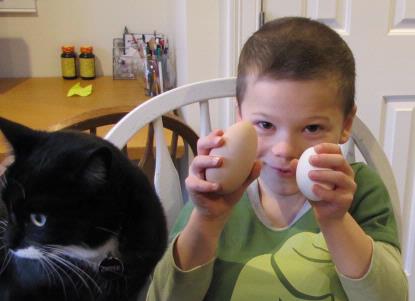
Aquatic critters usually produce jelly like eggs. Think frog spawn. A principle adaptation that allowed tetrapods to live on land was the amniotic egg. Tetrapods are the four footed vertebrate animals: platypuses, dogs, birds and even according to some definitions members of the House of Representatives (they appear to be spineless invertebrates).
A fertilized egg is alive, so it eats, uses oxygen and expels wastes. For the slimy eggs of a frog, waste disposal is little problem – they just pollute the water (just like us!). Food comes from the yolk that mom leaves them and they absorb oxygen from the water. The shelled egg of the land dwellers couldn’t accomplish these things as easily.
Biology textbooks sometimes say that the an-amniotic egg (without amniote) relies on the pond, whereas the terrestrial egg surrounds itself in a mini-pond. There’s even a little waste disposal container, the elegantly named “allantois.” That’s where embryonic chicken poop/pee goes in a fertilized egg. The mini-pond and septic unit are enclosed by some sort of hard case.
This case is great for preventing desiccation. But it means that fertilization couldn’t happen in a “fishy manner.” Or at least couldn’t happen the way fish do it, there’s plenty of fishy fertilization. Most fish (with the weird exception of sharks, rays and their kin) and many amphibians perform fertilization externally. The male delivers the sperm packet to the eggs outside of either the male or female organism – kind of like sperm FedEx.
A hard shelled egg makes sperm FedEx impossible, but it just so happens that millions of years prior to the first hard shells, some frogs and toads had already started using a new form of fertilization: amplexus, or clasping. The male climbs on top of the female and fertilizes the eggs as they emerge from her cloaca (the single in-out hole at the south end). This helps ensure paternity and is also a good way to show your lady friend that you care, because everyone needs a hug, even frogs.
Some frogs even have specialized sperm delivery organs that allow them to insert the sperm directly into the female’s cloaca. Sorry if that’s a bit graphic. This means that fertilization could happen inside the female before the egg’s hard shell forms. Dinosaurs may or may not have had a penis (at least males), but some birds do. Birds that are more similar to dinosaurs have retained penises, whereas some of the more distantly related birds have lost it. Chickens, for instance, lack penises and instead pass the sperm in what is known as a “cloacal kiss.” We do not know how dinosaurs like stegosaurus handled this situation, but I’m guessing it was a little prickly.
Most animals don’t lay a lot of eggs because they can only handle a few young. At least theoretically my family is supposed to be able to handle two, but most of the time 0.75 children seems like it’d be easier. Modern chickens have been bred to make lots of eggs (up to one a day) without, but they stop when molting. Once they’ve regained energy after molting, they sometimes lay an enormous egg.
The egg we harvested yesterday afternoon marks the end of an egg drought for one of our hens. As the youngest boarder demonstrates it’s nearly twice the size of a factory egg. Not surprisingly it contained two yolks. Two potential chickens (without a rooster there wasn’t much potential of course). The yolks look nearly identical, but these would have been entirely different chickens with hopes and aspirations. Actually, probably not they’d just be chickens walking around in their own poop and fighting about grubs, hoping for a cloacal kiss.


